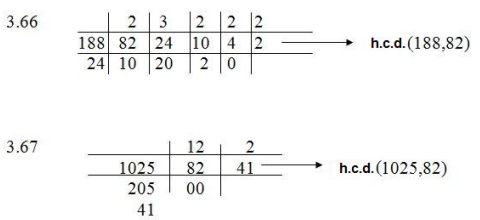ANOTHER METHOD FOR CALCULATING THE H.C.D.
This method consists in carrying out a series of divisions with specific numbers.
This is a very simple way for calculating the h.c.d. for two or more numbers.
First, we draw a chart like the one below:

We are going to calculate the h.c.d. of (164,72)
We write these two numbers in order. We write the highest number first:

Now, we start by dividing 164 by 72. We find out that 72 can divide 164 in two parts. We write the quotient in the box on top of 72. 72x2=144. We subtract 144 from 164, as if it were a normal division. We write the remainder, which is 20, under 164. This is how it should look like:

We write the remainder, 20, next to 72 as a new denominator and we continue dividing:

Now, we have to divide 72 by 20. We have 3 as a new quotient and we write it on top of 20. When we multiply 3 by 20, we get 60. We subtract it from 72. The remainder, 12, will be placed under 72:

We write the new remainder as a new denominator, next to 20. We divide 20 by 12. The new quotient, 1, is placed on top of 12. When we multiply 12 by 1, we get 12. We subtract the answer from 20, we get 8 as a new remainder. We write it under 20:

We write the new remainder, 8, as a new denominator. We now divide 12 by 8. We write the new quotient, 1, on top of 8. When we multiply 8 by 1, we get 8. We subtract it from 12. The remainder, 4, goes next to 8 as a new denominator. We also write 4 under 12:

Now, we have got to divide 8 by 4. We write the quotient, 2, on top of 4. Since it is an exact division BECAUSE THE REMAINDER IS ZERO, THE LAST DENOMINATOR, 4, IS OUR H.C.D. Now, look at the chart and the way it is supposed to look:

In this very simple form, we have calculated that:
h.c.d. (164,72) = 4
3.65 Let's calculate the h.c.d. for (5293,4757) using successive divisions:
a) Draw the chart.
b) Place the numbers in the first two middle cells. Remember to do this from the highest number to the smallest.
c) Divide the highest number by the smallest writing the quotient on top of the denominator.
d) Every remainder different from zero will be written in as a new denominator (in the middle). If we get zero as a remainder, our work is done. The last denominator is our h.c.d.
We calculated the h.c.d. for (5293,4757) showing the solution to the exercise:

3.66 Calculate the h.c.d. for (188,82) using the method of successive divisions.
answers: 2.
3.67 Calculate the h.c.d. for (1025,82) using the method of successive divisions.
answers: 41.
In case you had any problems with the exercises, here you have the solutions for the two exercises:


